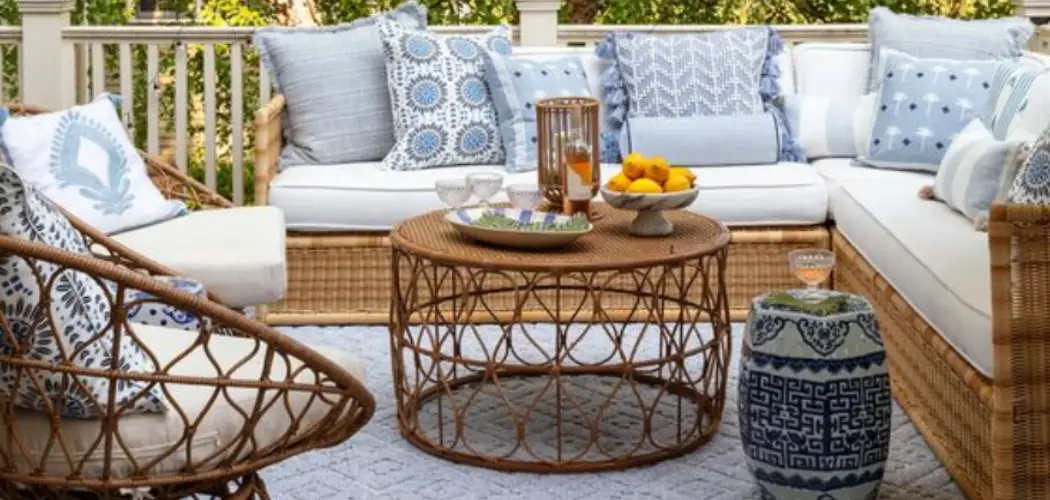Rattan outdoor furniture is a stylish and versatile choice, perfect for creating a cozy and inviting outdoor space.
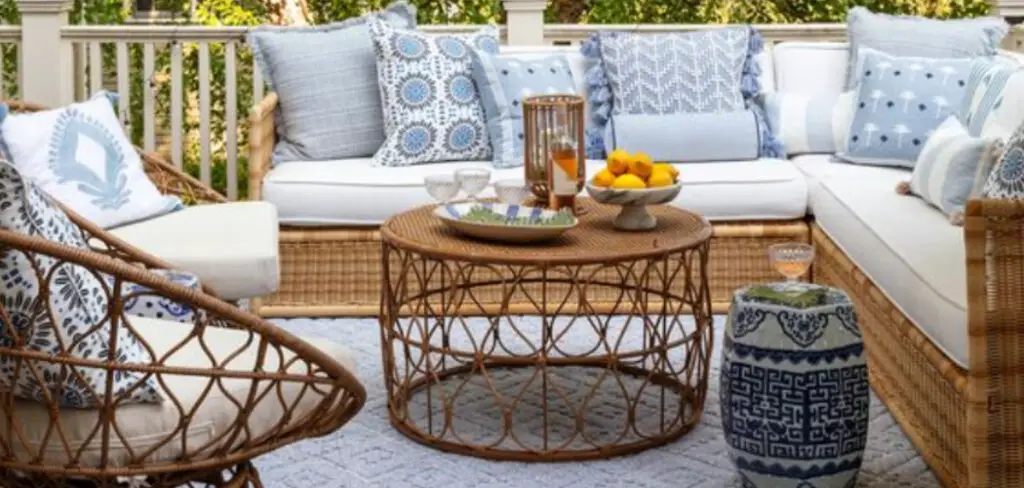
However, to keep it looking its best over time, proper care and protection are essential. Exposure to sunlight, rain, and fluctuating temperatures can cause wear and tear. This guide will provide practical tips for how to protect rattan outdoor furniture.
What is Rattan Outdoor Furniture?
Rattan outdoor furniture is crafted from the flexible stems of rattan palms, a type of vine-like plant native to tropical regions. Known for its lightweight yet durable properties, rattan has long been a popular material for outdoor furniture.
It comes in two types—natural rattan, which is woven from the real plant, and synthetic rattan, often made from polyethylene, which is designed to mimic the look of natural rattan while being more weather-resistant.
These furniture pieces are celebrated for their intricate weaves, natural aesthetic, and ability to complement various outdoor styles, making them a timeless choice for patios, gardens, and balconies.
Why Rattan Outdoor Furniture Needs Protection
While rattan outdoor furniture is both stylish and durable, it still requires proper care and protection to maintain its appeal and longevity. Natural rattan is particularly vulnerable to moisture, as excessive exposure to rain or humidity can cause it to weaken, sag, or develop mold.
Even synthetic rattan, though more weather-resistant, can fade or become brittle over time when exposed to prolonged direct sunlight.
To protect your rattan furniture, it’s important to use weatherproof covers when not in use, clean it regularly with a soft cloth and mild detergent, and store it indoors or in a sheltered area during extreme weather conditions. Taking these steps ensures your rattan furniture remains an elegant and functional addition to your outdoor space for years to come.
10 Methods How to Protect Rattan Outdoor Furniture
1. Apply a UV-Resistant Sealant to Prevent Sun Damage
One of the most critical steps in protecting rattan outdoor furniture is applying a UV-resistant sealant. Rattan, whether natural or synthetic, is vulnerable to the harsh effects of sunlight. Constant exposure to UV rays can cause fading, dryness, and brittleness over time.
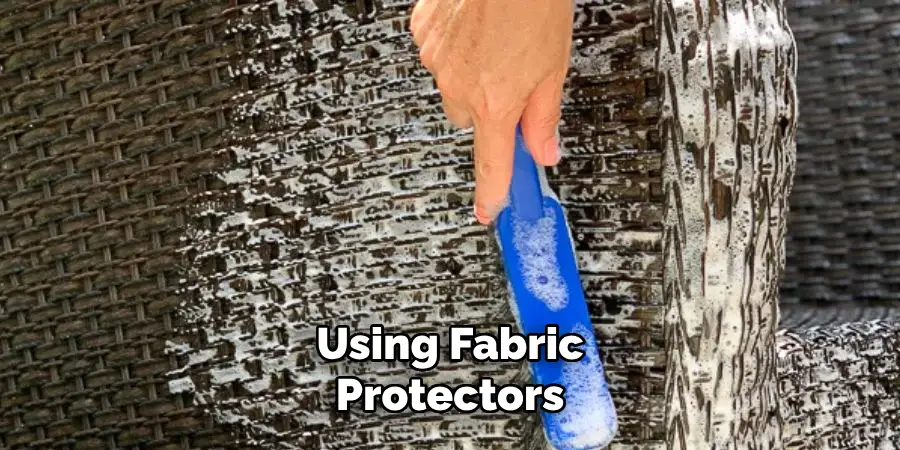
By applying a clear, UV-protective lacquer or spray varnish specifically designed for outdoor use, you create a transparent shield that reflects harmful rays and helps the fibers retain their flexibility and color.
Be sure to apply the sealant in a well-ventilated area, preferably on a dry day, and let each coat fully cure before using the furniture. This single step can extend the life of your rattan pieces dramatically.
2. Keep Rattan Under Shade or Shelter When Possible
While rattan is often sold as outdoor furniture, it’s important to remember that even the best-made rattan (especially natural varieties) isn’t immune to the elements. Keeping your furniture under a covered patio, pergola, or awning greatly reduces exposure to sun, wind, and rain.
These sheltered environments prevent long-term degradation by moderating temperature changes and shielding from direct downpours or drying UV rays. If a full patio cover isn’t feasible, consider using a large market umbrella or creating a shade screen. Simple shade preservation can drastically reduce the speed at which rattan weathers or cracks.
3. Use Waterproof Furniture Covers During Harsh Weather
Investing in high-quality, waterproof furniture covers is a practical and protective choice. These covers are typically made from breathable, weatherproof fabric that guards against rain, snow, dust, and UV exposure. Choose covers that are the right size and shape for your rattan furniture to prevent wind damage or water pooling.
A snug but not overly tight fit works best. Use the covers daily if you live in a high-rainfall area, or at least during storms and off-season months. Covers add an additional layer of protection and prevent moisture buildup, mold, and dust accumulation during idle periods.
4. Clean Regularly Using Mild Soap and Soft Tools
Routine maintenance is one of the easiest and most effective ways to preserve rattan furniture. Dust, bird droppings, and plant matter can build up on rattan surfaces, leading to stains, mold, or attractants for pests. To clean, use a soft-bristled brush or vacuum with a brush attachment to remove dirt from crevices.
For deeper cleaning, mix a mild soap solution with warm water and gently wipe the rattan using a sponge or cloth—avoid soaking it. Rinse lightly with clean water and dry thoroughly with a soft towel. Regular cleaning not only keeps your furniture looking fresh but also prevents long-term grime from weakening the material.
5. Avoid Excessive Moisture—Keep Furniture Dry When Not in Use
Water is one of the biggest enemies of natural rattan. Although synthetic rattan is more water-resistant, it’s still advisable to keep any rattan furniture as dry as possible. After rainfall, dry the furniture promptly using a towel, and ensure it’s placed in a well-ventilated area to air out completely.
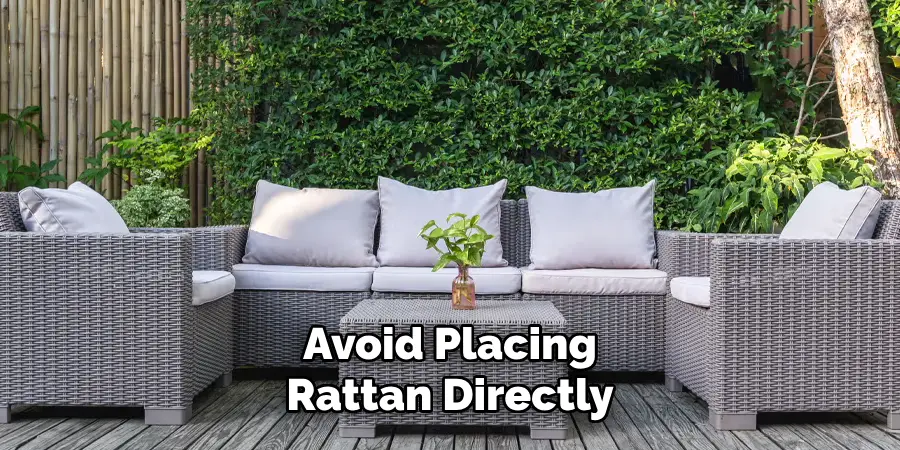
Avoid placing rattan directly on wet grass, soil, or unsealed surfaces, as moisture can wick upward into the frame. If your furniture becomes soaked, let it dry completely in indirect sunlight—never under intense heat or with a hairdryer—as sudden temperature changes can cause splitting.
6. Elevate Furniture to Prevent Ground Moisture Absorption
Keeping your rattan furniture slightly elevated can significantly reduce contact with ground moisture. Use rubber or plastic furniture feet, caps, or risers to lift the legs above any damp surfaces. This is particularly important if your furniture sits on grass, soil, or an unfinished patio where moisture retention is high.
Elevation not only protects the legs from rot and warping but also promotes better air circulation underneath the furniture, which helps it dry faster after exposure to dew or rain. It’s a small, inexpensive adjustment with big protective benefits.
7. Re-Apply Protective Coatings Seasonally for Long-Term Durability
Just as with wood decks or fences, rattan furniture benefits from seasonal reapplication of protective finishes. If your pieces are exposed to fluctuating weather or stored outside year-round, re-coating them every six to twelve months ensures the sealant remains effective.
First, clean the furniture thoroughly, allow it to dry, and lightly sand any areas where the finish has worn or flaked. Then, apply a fresh coat of clear outdoor varnish or sealant to lock in the protection. This upkeep keeps the fibers conditioned, blocks out moisture, and maintains the attractive sheen of your rattan.
8. Avoid Overloading or Sitting Heavily on Fragile Areas
While rattan is naturally strong, its woven design can be vulnerable to undue pressure, especially if it’s weakened by sun or moisture exposure. Avoid placing heavy items on armrests or leaning heavily on unsupported areas, and ensure guests don’t misuse it (such as by standing on it).
If the furniture includes glass-topped tables, make sure the glass is properly supported and not putting stress on the rattan weave beneath. Distributing weight evenly and using seat cushions to reduce pressure will help maintain the furniture’s shape and structural integrity over time.
9. Store Indoors During Winter or Prolonged Bad Weather
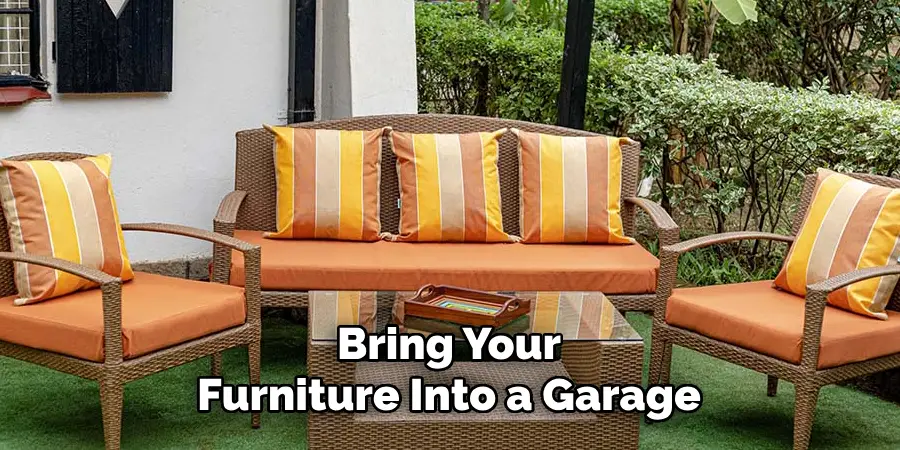
When facing off-season months or extreme weather, it’s best to store rattan furniture indoors. While synthetic rattan is more durable than natural types, all rattan benefits from being protected from freezing temperatures, snow, and prolonged rain.
Bring your furniture into a garage, basement, shed, or even an indoor sunroom. If storage space is limited, at least move pieces to a sheltered, dry area and cover them thoroughly. Winter storage gives your furniture a much-needed break and extends its usable life by several years.
10. Rotate Furniture Position to Ensure Even Wear
Like most outdoor furniture, rattan benefits from being rotated or repositioned regularly. If one side of your set is constantly facing the sun or elements, it will weather unevenly, fading or drying faster than the rest. Every few weeks, rotate chairs, tables, or sectionals to ensure more even exposure.
This also allows you to inspect all sides periodically for signs of wear, pests, or mold. Rotating prevents patchy sun bleaching, maintains structural balance, and gives the entire set a consistent, well-cared-for appearance.
Maintenance and Upkeep
Regular maintenance is essential to preserve the condition and appearance of rattan furniture. Start by cleaning it weekly with a soft cloth or a brush to remove dust and debris. For deeper cleaning, a solution of mild soap and water works effectively; however, avoid soaking the furniture to prevent weakening the fibers.
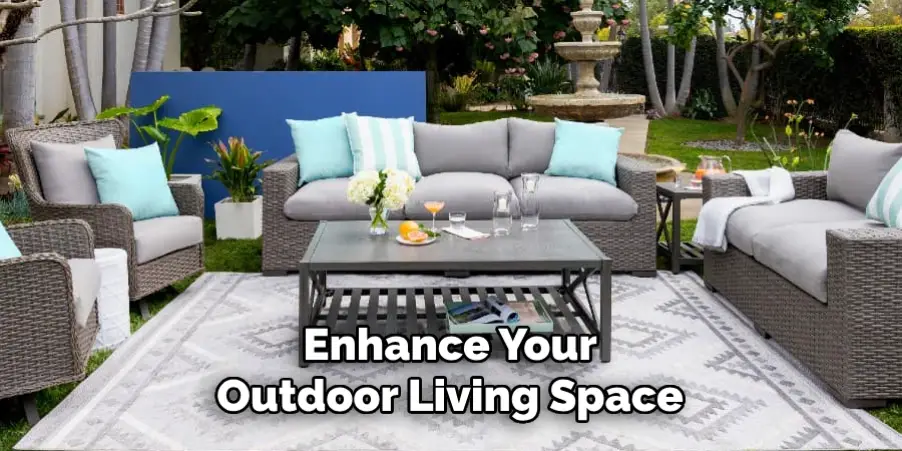
Inspect for any loose or fraying strands, and make timely repairs with appropriate adhesives to maintain structural integrity. Additionally, reapplying a protective lacquer or varnish annually can provide extra resilience against moisture and UV exposure. With consistent care and attention, rattan furniture can continue to enhance your outdoor living space while standing the test of time.
Conclusion
Protecting rattan outdoor furniture is all about prevention, routine care, and environmental mindfulness. From applying UV sealants and keeping the furniture shaded to cleaning it gently and storing it during off-seasons, each method adds a valuable layer of defense against nature’s wear and tear.
By elevating the furniture, using proper covers, and rotating it regularly, you ensure even aging and maximum longevity. Rattan brings timeless elegance and warmth to outdoor spaces—but with proper attention and smart care, it can offer comfort and beauty for years to come.Maintenance and Upkeep

